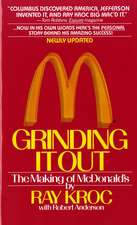Strategy, Structure, and Antitrust in the Carbonated Soft-Drink Industry
Autor Timothy Muris, David T. Scheffman, Pablo T. Spilleren Limba Engleză Hardback – 29 mai 1993 – vârsta până la 17 ani
Preț: 499.00 lei
Preț vechi: 689.39 lei
-28% Nou
Puncte Express: 749
Preț estimativ în valută:
95.49€ • 103.69$ • 80.22£
95.49€ • 103.69$ • 80.22£
Carte tipărită la comandă
Livrare economică 22 aprilie-06 mai
Preluare comenzi: 021 569.72.76
Specificații
ISBN-13: 9780899307886
ISBN-10: 0899307884
Pagini: 272
Dimensiuni: 156 x 235 x 19 mm
Greutate: 0.56 kg
Editura: Bloomsbury Publishing
Colecția Praeger
Locul publicării:New York, United States
ISBN-10: 0899307884
Pagini: 272
Dimensiuni: 156 x 235 x 19 mm
Greutate: 0.56 kg
Editura: Bloomsbury Publishing
Colecția Praeger
Locul publicării:New York, United States
Notă biografică
TIMOTHY J. MURIS is Foundation Professor of Law at George Mason University. He has served in numerous government positions including Executive Associate Director of the Office of Management & Budget, Executive Office of the President, Director of the Bureau of Competition and the Director of the Bureau of Consumer Protection, U.S. Federal Trade Commission.DAVID T. SCHEFFMAN is the Justin Potter Professor of American Competitive Enterprise at the Owen Graduate School of Management at Vanderbilt University, where he teaches Strategic Management and Marketing to MBA students. Prior to joining the faculty at Vanderbilt, he held several positions at the Federal Trade Commission including Director of the Bureau of Economics from 1985-88.PABLO T. SPILLER is the William B. McKinley Professor of Economics and Public Utilities and Professor of Government and Public Affairs at the University of Illinois. Professor Spiller has served as a consultant to the World Bank, the United Nations, U.S. Federal Trade Commision, and U.S. Department of Transportation on regulatory and antitrust matters, and is co-editor for the Journal of Economics and Management Strategy.
Cuprins
IntroductionA Strategic Analysis of the CSD IndustryThe Origins and Development of Soft Drink DistributionThe Modern Soft Drink IndustryStrategy and Structure in Soft Drink DistributionThe Organization of Distribution of Other Major Grocery ManufacturersAntitrust Theories of Bottler AcquisitionsAntitrust Challenges in the CSD IndustryIncreased Operating Efficiencies Arising From Captive Distribution: The St. Louis and Denver Pepsi-Cola FranchisesThe Output Effects of Captive Distribution: A Case Study of Sales in MEI MarketsThe Price Effects of Bottler AcquisitionsThe Competitive Effects of Bottler Acquisitions: The Stock Market EvidenceConclusion












